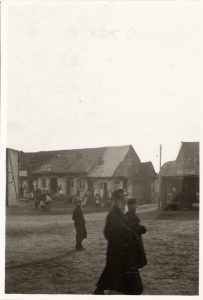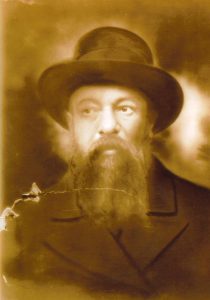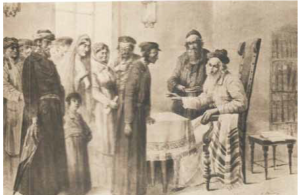This article was published in issue 56 | Adar 5781 | March 2021
In the summer of 1873, Rabbi Asher Perlov, master of the Karlin Hasidic dynasty (originating in Karlin, near Pinsk, in today’s Belarus), passed away in nearby Stolin. Only forty-six, Rabbi Asher left behind a daughter from his first marriage and a long-awaited son from his third. His followers hurriedly crowned the son, Yisrael, as their leader, though he wasn’t yet five years old.
Rabbi Yisrael of Stolin may have been the youngest Hasidic leader ever appointed, but he was by no means the only such boy rebbe, or even the first. Hasidim call a child who succeeds his father a yanuka, from the Aramaic word meaning a nursing infant. The few such cases were both famous and controversial, teaching us a great deal about Hasidic courts and their leadership.
Dynasties are one of the phenomena most closely identified with Hasidic groups. Lineage has always been an important element of Jewish spiritual leadership. The presidency of the Sanhedrin traditionally passed from father to son, and many of eastern Europe’s early modern rabbinic dynasties traced themselves all the way back to the House of David. In contrast, the Baal Shem Tov came from no distinguished family and passed his mantle on to his disciples – Rabbi Yaakov Yosef of Polnoye; Rabbi Dov Ber, the Maggid of Mezritsh; and Rabbi Pinhas Shapira of Korets. Yet from the 1780s, Hasidic leadership became increasingly hereditary.
Outside of Hasidism, rabbinic dynasties were seen as preserving a family’s scholarship and prestige. For Hasidim, however, their sainted leaders were a vital link in a chain of succession orchestrated by God Himself. Inherently holy, they bore a divine spark transmitted from father to son through the generations.
The hereditary nature of Hasidic leadership suggested a kind of royalty or aristocracy. Indeed, Louis XIV was crowned king of France when he was around five, more or less the same age as the Yanuka of Stolin took his father’s place. The Hasidic tendency to treat rebbes as royalty was seen by the movement’s opponents as proof of its deeply ingrained moral rot. Dynastic leadership, in their eyes, only increased the gap between classes in Jewish society while justifying an authoritarian hierarchy.
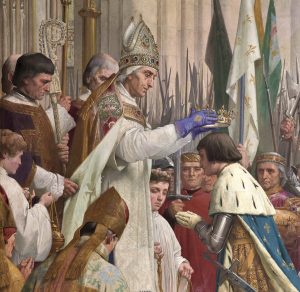 Hasidim treat their rebbe as royalty, preferring that his leadership pass to a direct descendant. Detail from Jules Eugène Lenepveu’s The Coronation of Charles VII, circa 1890, Paris Pantheon. Courtesy of Regards, Center for National Monuments in France
Hasidim treat their rebbe as royalty, preferring that his leadership pass to a direct descendant. Detail from Jules Eugène Lenepveu’s The Coronation of Charles VII, circa 1890, Paris Pantheon. Courtesy of Regards, Center for National Monuments in France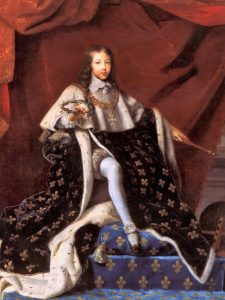 When Henri Testelin painted Louis XIV in 1648, the king was only ten years old. Courtesy of the Museum of the History of France, Palace of Versailles
When Henri Testelin painted Louis XIV in 1648, the king was only ten years old. Courtesy of the Museum of the History of France, Palace of VersaillesChild’s Play
Though crowning a yanuka to replace his father as grand master was perfectly logical from a dynastic point of view, could a boy do the job? Rabbi Barukh Mandelboim of Turov – a central figure in the Karlin Hasidic court – assured his followers that young Rabbi Yisrael of Stolin’s spiritual stature was far beyond his years:
Turn your steps and your hearts, and let your feet take you joyfully up to the abode of joy […], and journey to Stolin in time for the holiday of holy law-giving […]. For did not the master, his saintly grandfather, […] say in these very words, “The child’s hands grant protection”? In him you’ll find protection from the counsel of the evil inclination […], and all will be sweet and well with you, and you’ll be well-endowed both spiritually and physically. (Yehuda Leib Levin, “Discovery of the Yanuka in Stolin,” Ha-shahar, Tishrei 5635 [1874], p. 40 [Hebrew])
Jews in the town square of Stolin, home to the youngest known yanuka, 1929 YIVO Archives
Mandelboim wrote that the mere touch of the young rebbe’s hands worked like a charm – and that belief in his powers was more important than hearing his words. The rabbi reported that the Yanuka’s mother had appointed guardians to groom him for his role and support him until he reached adulthood. Meanwhile, they’d undertake some of his responsibilities. And Rabbi Barukh pointed out that the biblical King Jehoash was also crowned young – at age seven – under the guidance of the high priest Yehoyada.
Mandelboim’s effusive letter implies that the child’s position was far from secure. Perhaps the Hasidim feared that a boy could hardly provide the requisite leadership: addressing the burning issues of the time, inspiring with his words of Torah wisdom, performing miracles, representing his community before God, and offering personal counsel. Surely some avoided the yanuka’s court rather than consult a five-year-old regarding their business, family, or health problems.
One Hasid recalled his grandfather’s experience with Rabbi Yisrael:
My grandfather, Reb Pinhas Yosef Shapira (may he rest in peace), would go up to Stolin for the festivals of Shavuot and Hanukka and as the need arose, which it did fairly frequently: when he had to pay his yearly leasing fee but had no money, or when one of his sons received a summons from the army […]. And when it was time for the Hasid to return home, he’d go to Reb Yisrael Binyamin (the gabbai [court secretary]) and hand him a note for the rebbe, with the appropriate donation, and together they proceeded down the long corridors, looking for the rebbe in order to get a farewell blessing. When they found him, busy with his toys, the gabbai would address him with all due respect:
“Rebbe, Pinhas would like to go home to Gritsev, and he’s here for a farewell blessing.”
“Let him go in peace. What’s keeping him? Go in peace, Pinhas.”
Reb Pinhas approached the Yanuka and said: “Rebbe, my son David Aharon has been called for military physicals and asks your blessing to [help him be] released [from army service].”
“May it be as you say, Pinhas. May he be released.”
“Rebbe, my income could be better.”
“Better, better, may it improve. Goodbye, Pinhas.”
Leaving them standing there, he turned back to his games.
The gabbai solemnly repeated the Yanuka’s words: “Go in peace, Reb Pinhas. May God, blessed be He, help you, and may your son be released and your income improve, God willing, in the merit of the righteous.”
As the yanuka played, the Hasid would shake Reb Yisrael Binyamin’s hand and go home to his family full of hope and encouragement. (Stolin – A History of the Stolin Community and Its Environs, ed. Arye Avatichi and Yohanan Ben-Zakkai [Tel Aviv: Association of Stolin Emigrants in Israel, 1952], p. 154 [Hebrew])
The slight ambivalence reflected above contrasts sharply with a description of the same Yanuka of Stolin by Avraham Abish Shor in a Hasidic periodical:
Wonderful were his ways, modest and retiring in the extreme. As he played with other children his age […], he’d reveal great matters as if by chance through his apparently childish actions. […] They’d seat the yanuka at the head of the table, and he’d slip away and hide underneath […] and say, “How can I sit at the head of the table where God’s holy name stands before me, making my eyes ache?” (Avraham Abish Shor, “On the Golden Dynasty and the Holy Soul of Our Teacher, the Or Yisrael of Stolin, May His Merit Protect Us, Amen,” in Beit Aharon and Yisrael Almanac, vol. 6, pt. 4 [1991], p. 162 [Hebrew])
Yet even when a yanuka was somewhat older, his age made some uncomfortable. The grandson of Rabbi Hanokh Krupnik, a disciple of the Talne Rebbe of Sharhorod, Ukraine, wrote of his grandfather:
Since his youth, he’d followed Rabbi David of Talne. When Rabbi David died and his grandson, who’d just become bar mitzva, was appointed in his place, [my grandfather] retorted [in Yiddish]: “I’m not going to any youngster!” and ended his allegiance to Talne Hasidism. (Barukh Karu [Krupnik], “Three Towns,” in He-avar [The Past] – A Quarterly on the History of Jews and Judaism in Russia 20 [Elul 1973], p. 264 [Hebrew])
The rabbi’s indignation was by no means his alone. It expressed an ongoing tension between traditional Jewish leadership – essentially a meritocracy based on rabbinic learning – and the Hasidic version, based on hereditary sainthood.
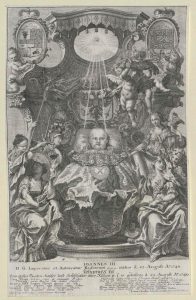 Kingship is dangerous for children, whose very existence blocks other claimants from the throne. Ivan VI of Russia was crowned at two months old, deposed a year later, imprisoned, and killed in the last of many attempts to free him before he turned twenty-four. Engraving of his coronation in 1740, emphasizing the divine election of royalty
Kingship is dangerous for children, whose very existence blocks other claimants from the throne. Ivan VI of Russia was crowned at two months old, deposed a year later, imprisoned, and killed in the last of many attempts to free him before he turned twenty-four. Engraving of his coronation in 1740, emphasizing the divine election of royalty Order in the Court
Some Hasidim actively opposed the appointment of a yanuka. In 1881, Rabbi Yeshaya Meshulam Zishe Twersky of Chernobyl died, leaving only one son – Shlomo Benzion. age eleven. Though the Chernobyl Hasidim appointed the boy to succeed his father, an anti-yanuka faction rallied around Shlomo Benzion’s uncle, Rabbi Barukh Asher of Chernobyl. This group wrote to Rabbi Avraham Twersky, the Hasidic master of Trisk (Turiisk, in today’s Ukraine), declaring the yanuka’s coronation idolatrous and asking the rabbi to support Rabbi Barukh Asher:
Empty, simple people got together, rough, uncouth laborers and artisans who can’t tell right from left. They gathered to profane the name of Heaven in public, setting up a stage and seating his young son on the rabbinic throne, though this tender young boy hadn’t yet read [from the Torah] or taught in his life.
His precious soul, hewn from the holy quarry, was lost among the fools who confused his power and his body and gave him donations and led him to the holy tomb, where they pronounced him rebbe and then and there began seeking his counsel, though he didn’t know what they were talking about. “They say to [a piece of] wood, ‘You are my father” (Jeremiah 2:27).
They don’t let the boy study God’s law, which could guide him on God’s path so that he might gradually follow in the footsteps of his holy forefathers, and thus might his deeds eventually approach his fathers’. Instead they confuse him and don’t leave him [in peace] to grow up until his beard fills in. They’re literally destroying a precious soul, Heaven forfend.
Even with our limited vision, we can see and understand the great sorrow that now pains his holy ancestors in Paradise. They’re troubled by the loss of this precious pearl, and even more so by the desecration of God’s name and the resulting weakening of belief in Him and in His servants in this generation. All their lives, they devoted themselves to sanctifying God’s name and instilling His faith in the hearts of Israel, that the common folk might seek out mouths of wisdom for sage and faithful counsel. Yet today our eyes see instead how a tender, ignorant lad is made a leader, and our hold on faith may slip for lack of stave and support, God forbid. (National Library of Israel, manuscript ARC 4° 1699, 10/b [Hebrew])
Expressing concern for the healthy development of their prematurely burdened leader, the writers also hint that he’s incapable of fulfilling his duties. He can’t answer his followers’ questions, and they take him and their kvitlekh – notes asking him to intercede with Heaven on their behalf – to his father’s grave. Though fledgling Hasidic masters do customarily visit their ancestors’ tombs for guidance, here the practice is presented as proof that the Yanuka of Chernobyl isn’t up to the job.
A further objection to the succession of a yanuka was the fact that he had the natural support of the personalities who’d run his predecessor’s court; the election of an easily dominated child protected their positions. His mother, too, automatically became a highly influential figure in his court. After Menahem Nahum of Talne succeeded his grandfather, a correspondent to Ha-melitz (The Advocate) lamented:
Talne: Since the saintly Rabbi Duvid’l passed away, peace has passed away from our town. He guided the flock in his wisdom, and no one plotted to disturb the peace, even if some secretly grumbled [against him] in their tents. He knew how to navigate the ways of the community with tolerance, so quarrels wouldn’t break out, […] but today our congregation is like most other congregations of Jacob in our land: there’s no end to the fighting […].
And all because of the holy child who sits on his grandfather’s throne with the help of the deputy, Reb Yaakov, the departed rebbe’s sister’s son. For since the boy is young, we’re ruled by a woman, namely his mother. The working-class commoners sanctify the holy child in his diapers and idolize him, ready to flay like a fish any who refuse to listen with all ears to every syllable uttered by the hereditary saint. (“Everyday Stories: In Our Land,” Ha-melitz, 17 Sivan 5643/June 22 1883, p. 698 [Hebrew])
His accession as a yanuka sent some of his grandfather’s followers scurrying to other Hasidic courts. Rabbi Menahem Nahum Twersky of Chernobyl and the town’s synagogue circa 1900
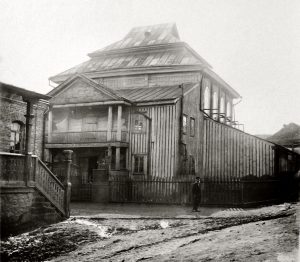
All in the Family
With all these problems, why did Hasidim continue appointing children, despite the resultant drop in popularity at their courts? One answer is court politics. Not infrequently, the instatement of a youngster was intended to thwart the succession of a rival family member. The hasty appointment of the Yanuka of Stolin, for instance, was designed to stop his mother from installing her thirteen-year-old son from a previous marriage instead. Using one yanuka to block another was simply an insider faction’s way of preventing a family of outsiders from taking control.
There was also a financial incentive. All the economic activity generated by a Hasidic master – donations, payment accompanying requests for blessings and personal advice – would be lost to his family, particularly his widowed mother, who had no income after her husband’s early demise.
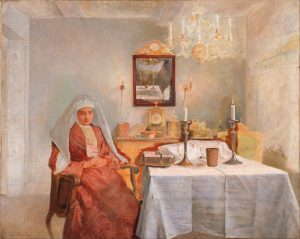 Widows of Hasidic masters could be left destitute, prompting them to promote the succession of their sons, however young. Isidor Kaufmann, Friday Evening, circa 1920. Courtesy of the Jewish Museum, New York
Widows of Hasidic masters could be left destitute, prompting them to promote the succession of their sons, however young. Isidor Kaufmann, Friday Evening, circa 1920. Courtesy of the Jewish Museum, New YorkFinally, as stated, Hasidim believed that the yanuka’s soul had God-given powers. The families of these children regularly described them as prodigies well before circumstances thrust them into the limelight. In Stolin, for example, Rabbi Asher Perlov had waited many long years for a male heir, and in the intense rejoicing surrounding his birth, the child was crowned with many grand titles and expectations. Similarly, Rabbi David Twersky, Hasidic master of Talne, whose only son died young, touted his grandson’s outstanding character long before the boy was due to succeed him.
Head Table
Dr. Samuel Aba Horodezky was descended from the Hasidic master Rabbi Menahem Nahum of Chernobyl, but embraced the Jewish Enlightenment (Haskalah). Nonetheless, his description of the Yanuka of Chernobyl’s coronation at his bar mitzva in 1883 is telling. Horodezky himself was only twelve at the time, but the experience left a profound impression:
Hundreds of Hasidim gathered from near and far to see the wonderful sight. For on that day he became a great Tsaddik (saintly leader), and from now on he would accept kvitlekh, dispense blessings, amulets, and [other] protective charms, and hold court at the head of the table (tish) on the Sabbath, singing Sabbath melodies. (Samuel Aba Horodezky, Memoirs [Dvir, 1957], p. 19 [Hebrew])
Hasidic courts became institutions in their own right, requiring a donation for every kvittl (written request) handed to their saintly leaders. Moshe Maimon, Visiting the Rebbe, St. Petersburg, 1899. Jewish Historical Institute Collection, Warsaw
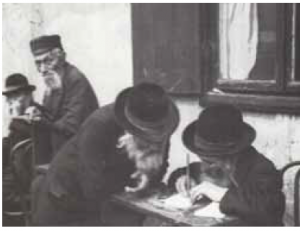 Members of the rebbe’s entourage were stationed outside his residence to write Hebrew kvitlekh for those who couldn’t. National Digital Archive, Warsaw
Members of the rebbe’s entourage were stationed outside his residence to write Hebrew kvitlekh for those who couldn’t. National Digital Archive, WarsawThe first Sabbath on which the yanuka presided also gets a mention:
There was utter silence in the hall. These Hasidim, most of whom had been lucky enough to sit at the elder tsaddik’s table, saw and felt again what they’d seen and felt then. There was no difference between the old, deceased tsaddik and the young, living one. All those gathered there looked only at him, never shifting their gaze from his movements and signals. He sat like one long accustomed, confident and loyal. (ibid., p. 20)
During the Sabbath singing, the yanuka surprised them with a new melody, then distributed the remnants of his meal (shirayim), as was customary. His audience marveled:
Great rejoicing broke out, seizing all the Hasidim. Affection and brotherhood overcame them, rich and poor alike, learned and ignorant, and they all stepped forward as one to dance and sing: “For unto us a child is born, unto us a son is given; and the government will be upon his shoulder” (Isaiah 9:5). Finally he too appeared and joined their dance. They said: At that moment, all merited a glimpse of the Shekhina [God’s presence]. (ibid.)
The verse from Isaiah has been interpreted by both Jews and Christians as a reference to the Messiah, who will continue the Davidic dynasty. As far as the Chernobyl Hasidim were concerned, the yanuka was also a redeemer, saving his dynasty from extinction.
Horodezky, who had no children, was particularly moved by youngsters and attributed special powers to some. In 1929, decades after the yanuka was crowned, Horodezky published an article in the first issue of the literary periodical Moznayim (Scales). “Yanuka (Mysterious Types)” was a brief summary of wonder children in Jewish tradition, from the Bible to the Hasidic dynasties. Along the way, Horodezky discussed the yanuka appearing in the Zohar, the child who amazes the sages with his insights – and inspired the title given to young boys appointed as Hasidic masters.
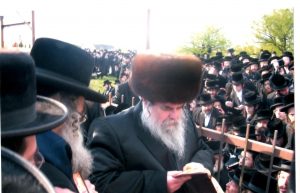 When Grand Rabbi Aharon Rokeach of Belz died in 1957, his nine-year-old nephew Yissachar Dov succeeded him but began fulfilling his duties only at age eighteen. Rabbi Yissachar Dov Rokeach, the present Belzer rebbe
When Grand Rabbi Aharon Rokeach of Belz died in 1957, his nine-year-old nephew Yissachar Dov succeeded him but began fulfilling his duties only at age eighteen. Rabbi Yissachar Dov Rokeach, the present Belzer rebbeThe Wonder of Childhood
Certain cultures view children and childhood symbolically. Jung emphasized the importance of the child in both civilization and religion. In many myths, the Swiss psychiatrist pointed out, the child represents innocence, simplicity, and purity, the primordial unity and harmony that preceded all discord and distinction. The child is not yet constrained by social norms or tainted by sexual desire.
Yet childhood is also associated with old age – the two outliers of human life – as the child carries the burden of the past into the future. Children are therefore often credited with wisdom beyond their years, which even adults have yet to achieve. Still whole and at peace with themselves, they’re considered a gift from God, connecting heaven and earth. This last aspect was often exactly how Hasidic masters were perceived. Hence the notion that a mere child could replace a saintly Hasidic leader.
Hasidism chose its leaders not so much for their erudition as for the holiness inherited from their fathers. Though a Hasidic master might be both learned and righteous, most important was his continuation of those who preceded him. For his Hasidim, the yanuka personified the pure holiness of the dynasty, and they hoped and believed that with time, that sanctity would trickle down to them too.
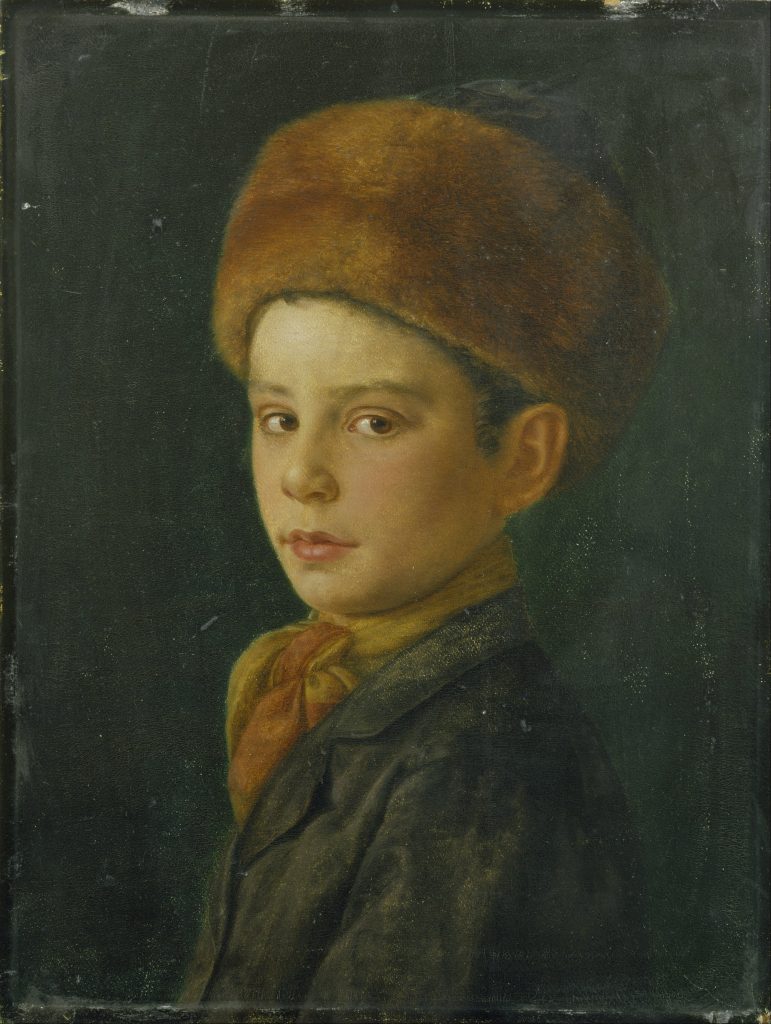 The innocence of youth bears an aura of sanctity. Isidor Kaufmann, Portrait of a Boy, 1895. Courtesy of the Jewish Museum, New York
The innocence of youth bears an aura of sanctity. Isidor Kaufmann, Portrait of a Boy, 1895. Courtesy of the Jewish Museum, New YorkFurther reading:
David Biale et al., Hasidism: A New History (Princeton University Press, 2017); Nehemia Polen, ”Rebbetzins, Wonder-Children, and the Emergence of the Dynastic Principle in Hasidism,” in Steven T. Katz, ed., The Shtetl: New Evaluations (Elie Wiesel Center, 2007), pp. 53–84; Jeroen Duindam, Dynasties: A Global History of Power, 1300–1800 (Cambridge, 2015).

